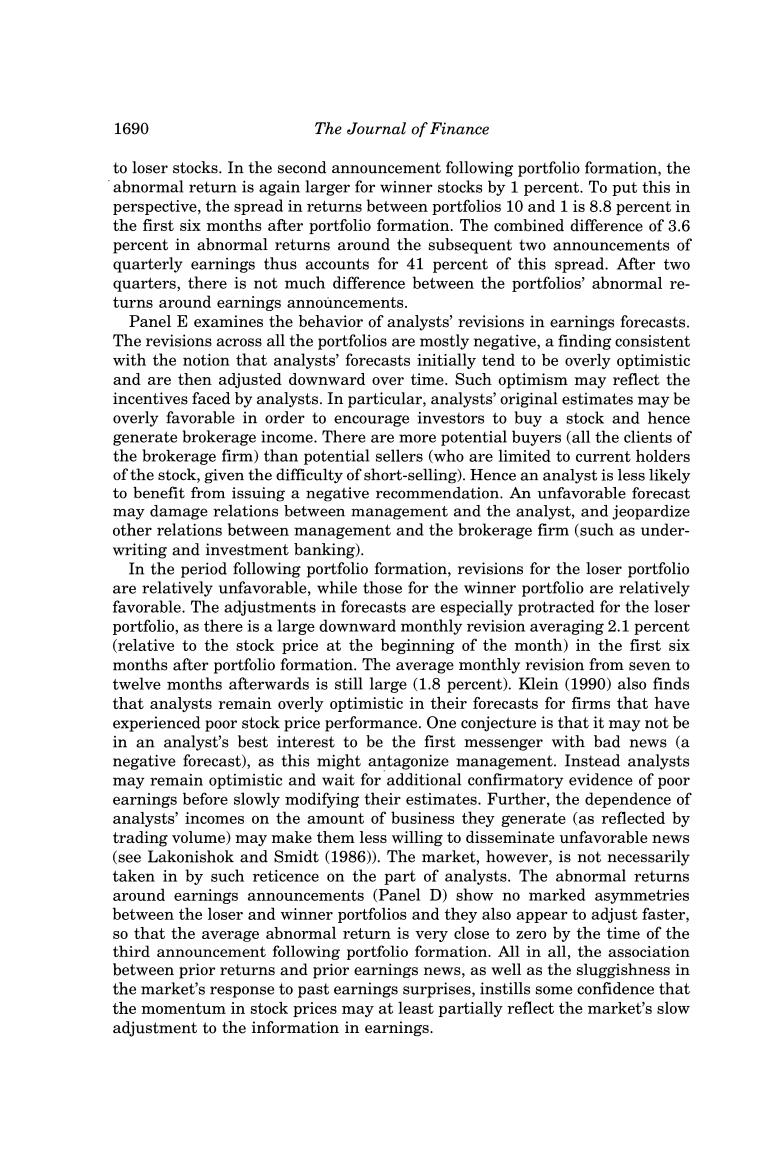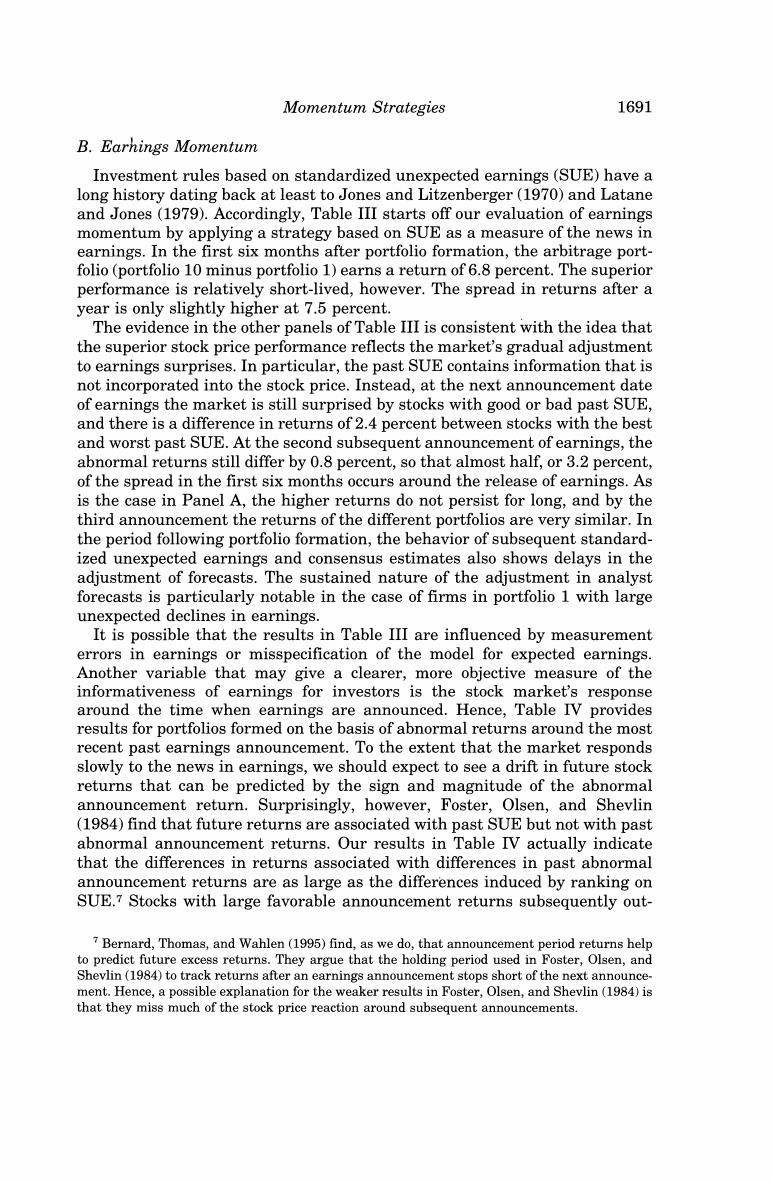
1690 The Journal of Finance to loser stocks.In the second announcement following portfolio formation,the abnormal return is again larger for winner stocks by 1 percent.To put this in perspective,the spread in returns between portfolios 10 and 1 is 8.8 percent in the first six months after portfolio formation.The combined difference of 3.6 percent in abnormal returns around the subsequent two announcements of quarterly earnings thus accounts for 41 percent of this spread.After two quarters,there is not much difference between the portfolios'abnormal re- turns around earnings announcements. Panel E examines the behavior of analysts'revisions in earnings forecasts. The revisions across all the portfolios are mostly negative,a finding consistent with the notion that analysts'forecasts initially tend to be overly optimistic and are then adjusted downward over time.Such optimism may reflect the incentives faced by analysts.In particular,analysts'original estimates may be overly favorable in order to encourage investors to buy a stock and hence generate brokerage income.There are more potential buyers (all the clients of the brokerage firm)than potential sellers(who are limited to current holders of the stock,given the difficulty of short-selling).Hence an analyst is less likely to benefit from issuing a negative recommendation.An unfavorable forecast may damage relations between management and the analyst,and jeopardize other relations between management and the brokerage firm (such as under- writing and investment banking). In the period following portfolio formation,revisions for the loser portfolio are relatively unfavorable,while those for the winner portfolio are relatively favorable.The adjustments in forecasts are especially protracted for the loser portfolio,as there is a large downward monthly revision averaging 2.1 percent (relative to the stock price at the beginning of the month)in the first six months after portfolio formation.The average monthly revision from seven to twelve months afterwards is still large (1.8 percent).Klein (1990)also finds that analysts remain overly optimistic in their forecasts for firms that have experienced poor stock price performance.One conjecture is that it may not be in an analyst's best interest to be the first messenger with bad news (a negative forecast),as this might antagonize management.Instead analysts may remain optimistic and wait for additional confirmatory evidence of poor earnings before slowly modifying their estimates.Further,the dependence of analysts'incomes on the amount of business they generate (as reflected by trading volume)may make them less willing to disseminate unfavorable news (see Lakonishok and Smidt(1986)).The market,however,is not necessarily taken in by such reticence on the part of analysts.The abnormal returns around earnings announcements (Panel D)show no marked asymmetries between the loser and winner portfolios and they also appear to adjust faster, so that the average abnormal return is very close to zero by the time of the third announcement following portfolio formation.All in all,the association between prior returns and prior earnings news,as well as the sluggishness in the market's response to past earnings surprises,instills some confidence that the momentum in stock prices may at least partially reflect the market's slow adjustment to the information in earnings

Momentum Strategies 1691 B.Earhings Momentum Investment rules based on standardized unexpected earnings(SUE)have a long history dating back at least to Jones and Litzenberger(1970)and Latane and Jones (1979).Accordingly,Table III starts off our evaluation of earnings momentum by applying a strategy based on SUE as a measure of the news in earnings.In the first six months after portfolio formation,the arbitrage port- folio(portfolio 10 minus portfolio 1)earns a return of 6.8 percent.The superior performance is relatively short-lived,however.The spread in returns after a year is only slightly higher at 7.5 percent. The evidence in the other panels of Table III is consistent with the idea that the superior stock price performance reflects the market's gradual adjustment to earnings surprises.In particular,the past SUE contains information that is not incorporated into the stock price.Instead,at the next announcement date of earnings the market is still surprised by stocks with good or bad past SUE, and there is a difference in returns of 2.4 percent between stocks with the best and worst past SUE.At the second subsequent announcement of earnings,the abnormal returns still differ by 0.8 percent,so that almost half,or 3.2 percent, of the spread in the first six months occurs around the release of earnings.As is the case in Panel A,the higher returns do not persist for long,and by the third announcement the returns of the different portfolios are very similar.In the period following portfolio formation,the behavior of subsequent standard- ized unexpected earnings and consensus estimates also shows delays in the adjustment of forecasts.The sustained nature of the adjustment in analyst forecasts is particularly notable in the case of firms in portfolio 1 with large unexpected declines in earnings. It is possible that the results in Table III are influenced by measurement errors in earnings or misspecification of the model for expected earnings. Another variable that may give a clearer,more objective measure of the informativeness of earnings for investors is the stock market's response around the time when earnings are announced.Hence,Table IV provides results for portfolios formed on the basis of abnormal returns around the most recent past earnings announcement.To the extent that the market responds slowly to the news in earnings,we should expect to see a drift in future stock returns that can be predicted by the sign and magnitude of the abnormal announcement return.Surprisingly,however,Foster,Olsen,and Shevlin (1984)find that future returns are associated with past SUE but not with past abnormal announcement returns.Our results in Table IV actually indicate that the differences in returns associated with differences in past abnormal announcement returns are as large as the differences induced by ranking on SUE.7 Stocks with large favorable announcement returns subsequently out- 7 Bernard,Thomas,and Wahlen(1995)find,as we do,that announcement period returns help to predict future excess returns.They argue that the holding period used in Foster,Olsen,and Shevlin(1984)to track returns after an earnings announcement stops short of the next announce- ment.Hence,a possible explanation for the weaker results in Foster,Olsen,and Shevlin(1984)is that they miss much of the stock price reaction around subsequent announcements